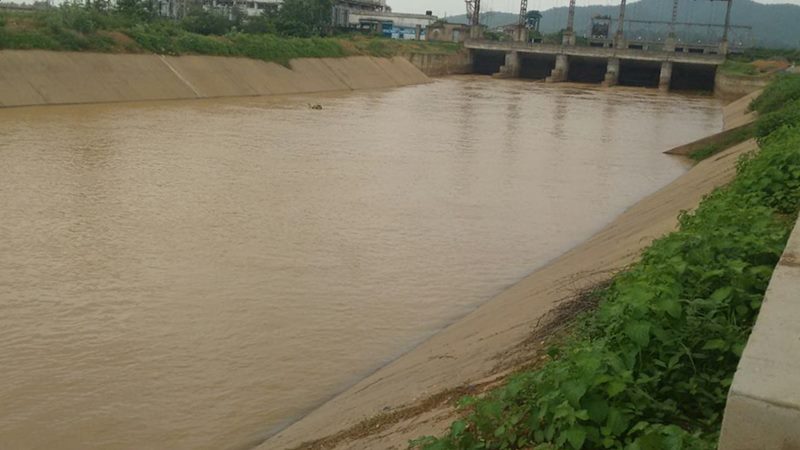Odisha’s Bhitarkanika mangroves, a notified Ramsar Convention wetland, are in serious danger due to diversion of fresh water for a mega water project, warn wildlife experts. Rengali Irrigation canals in Samal barrage are expected to lead to acute shortage of fresh water, increasing salinity in the river basin, thereby loss of mangroves and displacement of wildlife, claim the experts.
The Rengali dam, 70.5 metres tall and 1,040 metres wide, constructed across Brahmani River in Rengali village is located in Angul district. The reservoir formed by the dam is the second largest reservoir in Odisha. Rengali is known as a multi-purpose project both for irrigation as well as hydropower generation.
“This dam helps generate electricity while the irrigation canal (downstream to Rengali) in Samal barrage is the place from where water is extracted. Water is already being withdrawn from the river by industries and now more diversion of water due to the Rengali canal network will not leave any fresh water for the mangrove forests. The situation would aggravate once the project is operational,” Biswajit Mohanty, secretary of Wildlife Society of Orissa, an environment organisation, told Gaon Connection.
The irrigation canal network has been under construction for the last twenty years and is expected to be fully operational in the next four-five years.
“We want the state government to come up with a plan to maintain fresh water flow. The government should take note of this problem because now is the time to take steps,” said Mohanty. “Studies should be done to understand how much fresh water is needed for mangroves proliferation,” he suggested.
Impact on mangroves
Mangroves in Bhitarkanika are spread over an area of 195 square kilometres. Mangroves need both fresh water and salt water to survive, and the irrigation canal network will lead to acute shortage of fresh water flow in Bhitarkanika, warn the environmentalists.
Fresh water mixes with seawater near the lower end of Brahmani and Kharasrota rivers of the state to produce brackish water ideal for mangroves, which are very sensitive to changes in salinity. “Mangroves in Bhitarkanika will not survive on saline water alone. They need both kinds of water (salt and fresh) to survive,” stressed Mohanty.
Citing the example of Sundarbans mangrove forests in West Bengal, Mohanty said the famous Sundari trees in the region started disappearing soon after the Farakka Barrage was commissioned.
Ranjan Panda, convenor of Water Initiatives, and an environmentalist based in Sambalpur, seconded Mohanty.“Any reduction in fresh water flow to mangroves will impact them. Bhitarkanika is already a threatened fresh water ecosystem. This (Rengali Irrigation canals) is a very controversial project and is going to change the Bhitarkanika ecosystem,” he warned.
Industries vs mangroves
Rengali dam in Brahmani river is nearly 200 kilometres upstream of Bhitarkanika. The coal mines, steel and power plants, including Kalinga Nagar steel and power hub, are claimed to be drawing enormous quantities of fresh water from the Brahmani river, which is already affecting the mangroves. “Once the Rengali Irrigation canals are completed more water shall be diverted leaving almost no fresh water for downstream areas,” said the secretary of Wildlife Society of Orissa.
In a press statement issued on September 3, Mohanty highlighted that steel making requires enormous quantities of water and for every tonne of finished steel, about 100,000 cubic metres of water is required. “Against an available 4,400 million cubic metres of fresh water stored by Rengali Reservoir, about 4,318 million cubic metres, which is almost equal to the available water supply, shall be withdrawn from the river,” reads the statement.
The government claims that only 0.105 million cubic litres shall be withdrawn for the mega drinking water project. Even this will affect the sensitive water balance, it pointed out.
According to Panda, there is a need to prepare a status report of the Bhitarkanika ecosystem mentioning exactly what the threats are and which projects are going to disrupt the flow to the ecosystem. “We also need to fix responsibility so that the mangroves ecosystem is not impacted,” said the environmentalist.
“It is high time an expert committee is formed and technical assessment of all the ongoing and proposed projects is conducted. A redressal mechanism should also be put in place,” Panda added.
Threat to the livelihood
The massive diversion of fresh water is likely to affect the local flora and fauna as well as the livelihood of farmers and fishers dependent upon Brahmani and Kharasrota waters. Farmers cultivate paddy because of the fresh water availability. Once this flow is stopped, it is estimated that the water will become saline and unfit for both farming and fishing.
Besides “commercially important species like fresh water shrimp, mullets, mud crabs and bhekti are expected to disappear, leading to decline in incomes of thousands of fishermen of Kendrapada district”, said Panda.
The Bhitarkanika wetland, spread over 195 square kilometres, has a high level of biodiversity, 62 of the world’s 73 mangrove species are claimed to be found here.
The mangrove forests are also the habitat for more than 1,600 saltwater crocodiles. Mohanty pointed out that human and crocodile conflict are expected to increase as the crocodiles will migrate upstream once salinity increases.


















